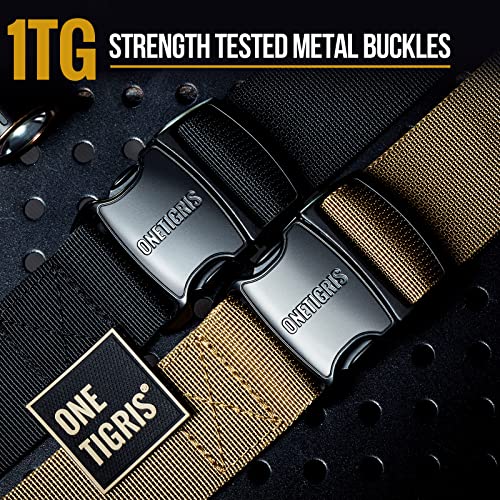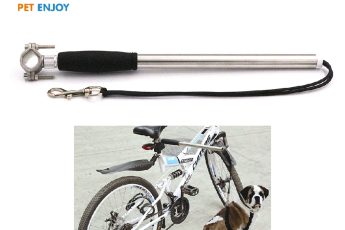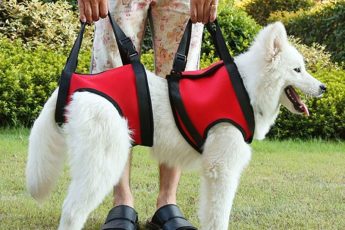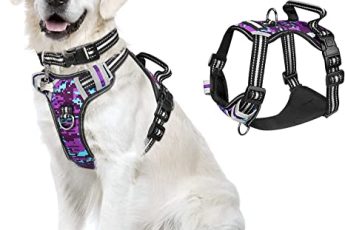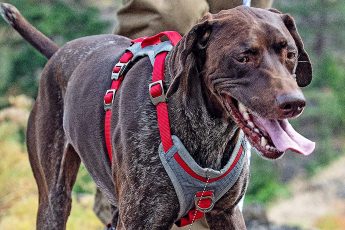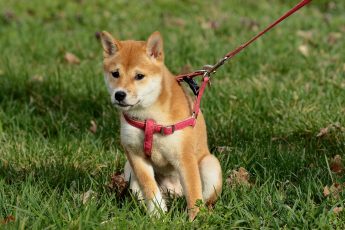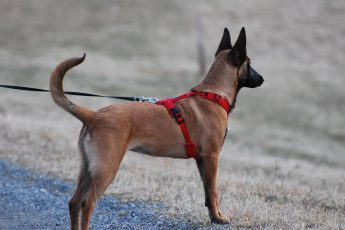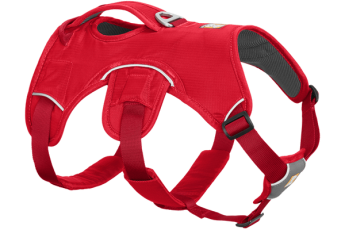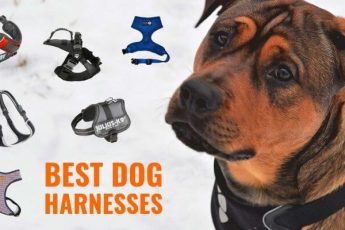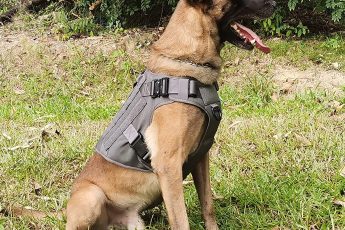When shopping for a dog harness, there are a number of things to consider. Before you buy one, make sure you know your dog’s size. To do this, measure around the center of your dog’s neck using a piece of string or cloth tape measure. Make sure that it fits snugly. You may also use a rigid ruler to get the exact measurement. Metal buckle dog collars typically have four sizing holes. The first hole represents the smallest collar size, while the remaining holes allow the collar to widen for comfort.
- FULL Metal Buckles Tactical Dog Harness: Team 1TG’s first full metal buckled tactical harness,which can bear great pulling force, ensuring your dog is safely harnessed during training, hunting, working, and any other occasions. 5 metal buckles strength tested at 397lb/180kg for size M and 485lb/220kg for size L/XL.
- Longer Length for a Snug Fit: ITG dog harness large breed specially designed snug-fit, zero-hindrance, easy on-and-off structure that doesn’t restrict shoulder and forearm movement with full adjustability to fit dogs of different ages, sizes and body builds
- 3 Stainless Steel D-rings: No pull dog harness featured with 3 stainless steel D-rings at the front and rear with a chest attachment point for no-pull trainings. The 3 stainless steel D-rings gives the handler/owner various leash attachment options such as long leashes on the back for hikes and runs, front chest leashing for no-pull training and walks in more crowded areas.
- Military-standard Material: ITG large dogs harness featured with 1000D Nylon construction of rugged durability and dirt/water/abrasion resistance, lightly padded for maximized comfort and mobility. Well padded in every pressure load point to protect your dog’s skin, while MOLLE system on the sides and modular attachment of add-ons such as treat totes, EDC pouches, glow sticks, litter bag dispensers, etc.
- Medium Large Dog Tactical Vest:M: 16- 23(Neck); 24- 32(Chest); 13(Back) L: 18-25(Neck); 27- 36(Chest); 15(Back) XL: 20- 29(Neck); 31- 40(Chest); 17(Back). Please measure your dog carefully before the purchase. Refer to the product image for the detailed size chart. Let us know anytime if youre not sure about the size, or you find the harness doesnt fit your dog well.
Prices pulled from the Amazon Product Advertising API on:
Product prices and availability are accurate as of the date/time indicated and are subject to change. Any price and availability information displayed on [relevant Amazon Site(s), as applicable] at the time of purchase will apply to the purchase of this product.
As an Amazon Associate we earn from qualifying purchases.
What kind of harness is best for a dog that pulls?
If you have a lanky dog that pulls and pushes you around, you may want to purchase a Y-necked dog harness. The Y-neck is safer for the dog, and the harness does not cross the dog’s shoulders or pinch its armpits. You can also purchase a harness with a built-in pull-resistance strap for dog sports, such as bikejoring and canicross.
Harnesses come in a wide range of styles and colors. You should choose one that fits your dog’s size, shape, and personality. Unlike collars, harnesses fasten around the dog’s chest and go behind its front legs. While collars can choke your dog, harnesses can be more effective for large breeds. They also provide better leverage for the owner.
What kind of harness can a dog not slip out of?

A traditional harness has straps that a dog can bite through to escape. Some dogs use this leverage to run around the neighborhood unbound. Others will chew on the straps to escape. The best option for these dogs is to buy a harness that is difficult for them to reach and made of durable materials. If you’re concerned about your pet’s safety, try a dog harness that has wide straps and thick, durable buckles.
One of the most common reasons a dog will escape a harness is a poor fit. Many owners order the wrong size for their dog or don’t measure it. If a harness is too tight, a dog can sense that something isn’t right. So they may slip out of the harness by trying to wiggle free. Make sure to take your time and measure your dog correctly before purchasing a harness.
What brand of harness do police dogs wear?
If you’re curious to know what the police dogs are wearing while they perform their duties, you can start by looking for a harness in your local pet store. These can be purchased in several sizes and colors, so you can choose the best one for your dog. For more information about police dog harnesses, visit Julius-K9’s website. This company produces high-quality dog harnesses, leashes, and other accessories for active dogs. Its name is protected internationally and is an EU-wide brand.
A tactical dog harness is made of heavy duty nylon and features reflective trimming. Whether your pup is working or just out walking, the reflective trim will make him more visible. These harnesses are commonly used by police and military working dogs, and they’re perfect for police work, since they allow the dogs to be more visible at night. Tactical vests are also popular for hunting dogs and dog walkers.
Do front clip harnesses hurt dogs?
There are a few pros and cons to front clip dog harnesses. Front-clip harnesses may not be comfortable for your dog. They may put too much pressure on the neck and throat when your dog pulls. Dogs should wear a collar or harness for comfort and to hold its ID tag. However, front-clip harnesses aren’t recommended for dogs with breathing problems. If you have a fear that your dog might get hurt while wearing a harness, a front-clip design might be an option for you.
Front-clip dog harnesses are often advertised as being safer than traditional harnesses. However, some experts don’t agree on the safety of these products. Always weigh the risk against the benefits to decide which is best for your dog. Many dog trainers recommend these harnesses because they allow owners to train hard-to-train pups without having to use an expensive training harness. These harnesses also reduce the chance of pulling by limiting your dog’s movement.
Are dog harnesses better than collars?
Harnesses are more comfortable for your dog than collars and can also offer more control over the walk. Choose a harness that’s adjustable and sturdy, and one with padding to prevent pressure on your dog’s neck and throat. This article explores the pros and cons of both types of dog collars and harnesses. Here are some of the key benefits of each type. And which one is right for your dog?
Choke collars work through force and intimidation. Although effective at training your dog to stop pulling, this behavior doesn’t generalize to other collars or leashes. As a result, they’re not a good choice for teaching your dog proper walking techniques. They should also never be left on your dog unattended. Harnesses also help prevent tangles, which can be painful for your dog.
Choosing a Dog Harness With Metal Buckles
When choosing a dog harness, consider the size of your dog’s neck. Do you want it to fit snug around the middle, or do you want it to be wide and comfortable? A cloth tape measure or string is a handy way to get the correct measurement. If you have a rigid ruler, you can measure your dog’s neck with a metal buckle. Many metal buckle dog collars feature four different sizing holes. The first hole should be the smallest size, with the remaining holes allowing you to adjust the size of the collar for comfort.
Why does my dog keep slipping out of his harness?
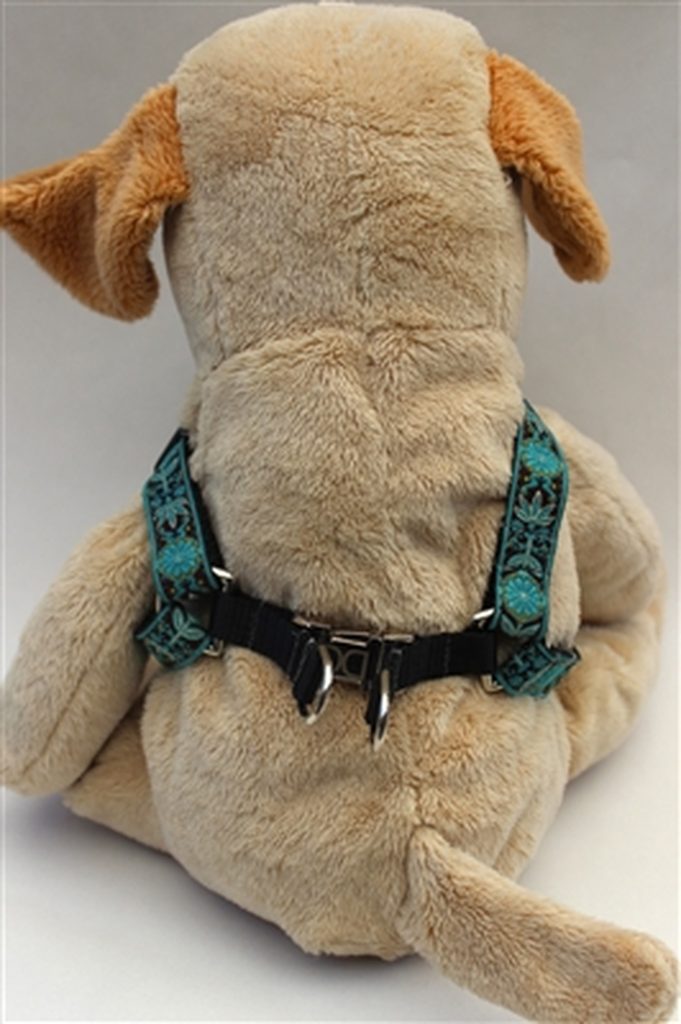
Sometimes, your dog may slip out of his harness with metal buckles for several reasons. It may be nervous or afraid or it could simply be an uncomfortable fit for your dog. Your dog may be slipping out of the harness because it is a new experience for him. If this happens, try adjusting the buckles or changing the location of the leash attachment. Try it on your dog while standing so that you can see if the problem is with the harness or the buckles.
One of the main reasons your dog slips out of his harness with metal buckles is the material. A cheap harness made of flimsy material may rub against your dog’s skin. As a result, your dog is more likely to slip his head and hands out of the harness. Ultimately, you should purchase a harness that has chew-resistant material. By keeping your dog comfortable, you will minimize the chances of your dog slipping out of his harness.
What gear do military dogs use?
What gear do military dogs use? These dogs use harnesses, leashes, and collars to protect themselves from harm. Different types of dogs serve different purposes and are outfitted with personal protection gear. Pointy-eared dogs perform tactical operations, while floppy-eared dogs are used for screening activities. As with human soldiers, military dogs also need to wear a vest and harness. Metal teeth and a metal collar are also common among military dogs.
Tactical dog gear is usually colored black, coyote brown, or ranger green. These colors help the dogs blend in with their surroundings. In comparison, hunting dogs often wear bright colors that draw the attention of other humans. The U.S. Army Special Operations Command is in need of new ideas to outfit its dogs with more advanced gear. These innovative ideas could include a wearable video camera or a video camera.
Why do dog trainers hate harnesses?
If you’ve ever taken your dog for a walk and noticed that they’ve been hiding under the blanket, you’ve probably wondered, “Why do dog trainers hate harnesses with metallic buckles?” In truth, harnesses can make daily walks with your dog more enjoyable, but they don’t teach your dog to behave. Rather, they merely teach your dog to obey commands.
A dog’s head is a sensitive area. While we have evolved to wear clothing over our heads, dogs’ heads are sensitive and they do not like to feel restrained. Metal buckles can actually damage your dog’s bone structure. A harness can cause a dog to feel unnaturally restricted and could even harm their bone structure over time. This is why most dog trainers despise harnesses with metal buckles.
Are no-pull harnesses cruel?
Some people question whether no-pull dog harnesses are cruel to dogs. This is a debate that can’t be easily answered in one sentence. The most common complaint relates to a dog’s discomfort while wearing a balance harness. While many people have expressed their displeasure over this issue, the truth is much more complicated than that. Here’s an example of how a balance harness can cause pain to a dog.
No-pull dog harnesses are designed to prevent a dog from pulling on a leash. The strap is tightened across the dog’s chest, causing it to walk with a shorter stride. While a single use of a no-pull harness won’t have any long-term effects, a few months of wearing one could cause changes to the dog’s musculoskeletal system.
Can a dog wear a collar and a harness?
Both collars and harnesses are used for identification purposes. However, you may wonder whether a harness is right for your dog. The answer to this question will depend on several factors, including breed, owner experience, and typical scenarios. A harness can be a good option for dogs with a shortened neck, or those with an extended neck, which are prone to respiratory problems. Listed below are some reasons to use a harness for your dog.
Both collars and harnesses are helpful when walking a dog. They help control your dog, prevent escape, and keep them comfortable. However, a harness is best for larger dogs. While a harness can be used for a large dog, a collar may be more appropriate for a small dog. For the best control, use a harness when walking your dog outdoors. If your dog is difficult to train, a harness might be the best option.


